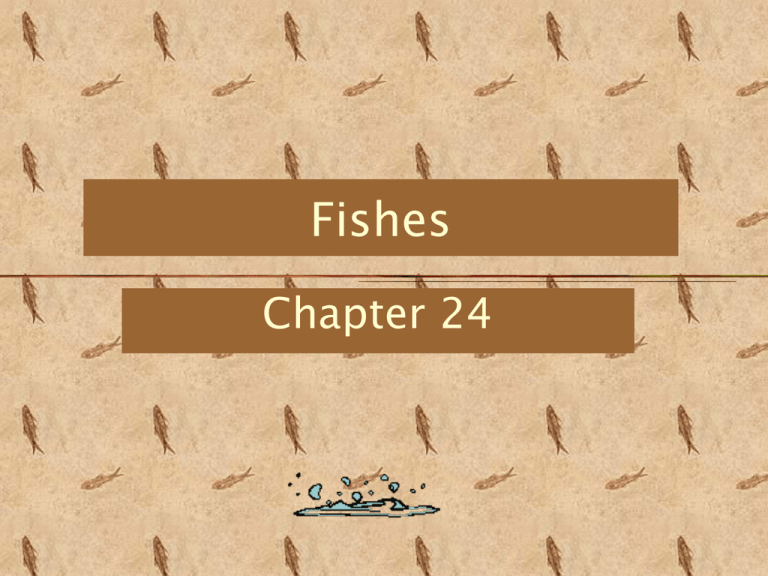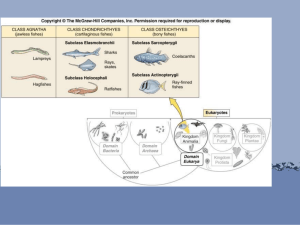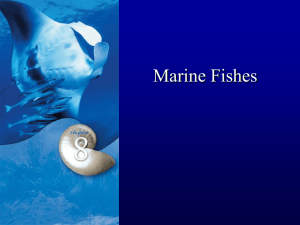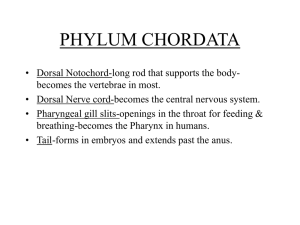
Fishes
Chapter 24
I. Diversity
26,000 living species—more species than all
other vertebrate groups combined
Adapted to live in a medium 800 x more dense
than air
Can adjust to salt and water balance of
environment
Gills extract oxygen from water that has 1/20 th
the oxygen of air
Aquatic environment both shaped and
constrained their evolution
II. Ancestry and Evolution
A. Ancestor
Descended from freeswimming protochordate
ancestor
B. Agnathans
Earliest fish-like vertebrates
Include extinct
ostracoderms, and living
lampreys and hagfishes
C. Placoderms
Fish with paired appendages
and jaws that went extinct in
Carboniferous with no living
descendants
D. & E.
D. Cartilaginous Fishes
Lost heavy armor and
adopted cartilage as
skeleton
Flourished during some
periods, becoming nearly
extinct during others
E. Acanthodians
Resemble bony fish but have
heavy spines on all but
caudal fin; sister group to
bony fishes
Went extinct in lower
Permian
F. Bony Fishes
Dominant fishes today
2 distinct lineages—ray finned and lobe finned
Ray-finned radiated to form modern bony fishes
Lobe-finned include lungfishes, the coelacanth,
and are sister group to tetrapods (amphibian
ancestors)
III. Superclass Agnatha: Jawless Fishes
A. Characteristics
Lack jaws, internal ossification, scales, or
paired limbs
Pore-like gill openings and eel-like body
B. Class Myxini: Hagfishes
43 species
Entirely marine
Scavengers and predators of
annelids, molluscs, dead or
dying fishes, etc
Nearly blind but locates food by
acute sense of smell
Rasps hole into prey then eats
from inside out with plate-like
tongue
Glands secrete substance that
becomes slimy in contact with
seawater
C. Class Cephalaspidomorphi
1. Diversity
41 species; 22 in North
America and of these,
half are non-parasitic
brook variety
Marine lampreys can
grow to length of 1 m.
All lampreys reproduce
in freshwater streams,
dying soon after
2. Parasitic Lampreys
Attach to fish by suckerlike mouth and sharp
teeth rasp away flesh
Anticoagulant injected
into wound to stimulate
flow of blood
Wound may be fatal to
host fish
Non-parasitic lampreys do
not feed; digestive system
degenerates and fish die
after reproducing, within
2-3 years
3. Sea Lamprey Invasion
No lampreys existed in
Great Lakes prior to 1829
when shipping canals
were built
By the 1940’s, they
existed in all the lakes
They decimated almost all
fish species until
populations finally
declined due to lack of
food and control
measures
IV. Class Chondrichthyes
A. Overview
850 species nearly all marine; 28 species live in freshwater
Ancient lineage but have survived due to well-developed sense
organs and powerful jaws making them successful predators
Largest living vertebrates, after whales, reaching up to 12 m in
length
Whale
shark
reaches
43’ in
length
B. Subclass Elasmobranchii
1. Sharks
A. Orders
Carcharhiniformes—tiger and bull sharks
which are coastal sharks and the
hammerhead
Lamniformes-- white and mako sharks
which are large pelagic sharks
Squaliformes—some of these are deep sea
dwellers like dogfish sharks
Orectolobiformes—carpet sharks like
bamboo, nurse, and whale sharks
Sharks
More Sharks
b. Outer Physiology
Streamlined fusiform body
shape
Pointed nose with paired
nostrils in front of ventral
mouth; on hammerhead,
nostrils on ends of “hammer”
Lateral eyes without lids
Tail has longer upper lobe
(heterocercal)
Paired pectoral and pelvic fins,
1-2 dorsal fins, 1 caudal fin,
and sometimes an anal fin
Tough, leathery skin with
placoid scales that reduce water
turbulence
Body Structures of a Shark
c. Senses
Olfactory organs can detect
chemicals diluted 1/10 billionth
their original concentration
Lateral line senses low
frequency vibrations of prey
over large distances
Excellent vision, even in dim
water, used at close range
At close range, sharks are
guided to prey by electric fields
surrounding all animals
d. Inner Physiology
Sharp triangular teeth in upper
and lower jaws; arranged in
rows that are constantly
replaced
Mouth leads to pharynx with
openings to gill slits
Osmoregulation accomplished
by rectal gland which secretes
sodium chloride; nitrogenous
compounds are also retained in
blood to increase solute
concentrations, making more
on par with seawater
e. Shark Attacks
Only 32 species ( of 350) have been
documented to attack humans with
another 36 considered potentially
dangerous; these typically are the larger
size sharks; 80 % of sharks are harmless
Great white, tiger, and bull sharks are the
more aggressive species
50-75 attacks occur each year, with 8-12
fatalities; in contrast 30-100 million
sharks are killed every year
Attacks usually occur by sandbars, steep
drop offs, or by river inlets and are
associated with mistaken
identity,territorial behavior, or feeding
behavior
2. Rays
A. Order
Rajiformes—skates, sawfish rays, electric rays,
stingrays, manta rays and others
Make up half of all species of Elasmobranchii
b. Form and Function
Specialized for benthic life
Flattened dorsoventrally; enlarged pectoral fins
are used as swimming wings
Water used in respiration enters large spiracles in
head
Teeth adapted to act as rollers to crush
invertebrates and sometimes small fish
Stingrays have whip-like tail with spines and
venom glands
Electric rays have electric organs on sides of head
C. Subclass Holocephali: Chimeras
31 species
Ratfishes
Diverged from earliest shark lineage
Mouth has flat plates for crushing invertebrates;
also feeds on seaweed and small fish
D. Reproduction and Development
Internal fertilization
Oviparous sharks and rays lay an egg capsule
immediately after fertilization that attaches to kelp with
tendrils; may take up to 2 years before mini adult hatches
Ovoviviparous sharks retain fertilized eggs in
reproductive system where they are nourished by yolk of
egg; “live” birth
Viviparous sharks nourish embryos with maternal
bloodstream; “live” birth
Live births make it more likely more of the young survive
but no other care is given after birth
Embryo Development
V. Superclass Osteichthyes
A. Origin, Evolution, and Diversity
Lineage developed in Silurian and now accounts for
96% of all fishes and all tetrapods
Bone replaces cartilage as fish develops
Lung or swim bladder evolved from an extension of
the gut; gas filled, it aids in buoyancy
Bony operculum, a flap covering the gills that rotates
outward, draws water more efficiently over them
Specialization of jaw musculature improves feeding;
also unique dental characters
B. Class Actinopterygii
23,600 species comprise the ray-finned fishes
Most familiar fish type
a. Palaeoniscids
Earliest forms, existing from late Silurian to late
Paleozoic
Small, large eyes, dorsal fin with bony rays,
heterocercal tail, and interlocking scales
Survived as other fishes declined, suggesting
some adaptive advantage
Gave rise to the chondrosteons and the
neopterygians
b. Chondrosteons
Most primitive characteristics
Heterocercal tail and ganoid scales
Living species include sturgeons, paddlefishes,
and bichirs
c. Neopterygians
One lineage gave rise to
modern bony fishes, the
teleosts
Living species are bowfin
and gars which gulp air
and use vascularized swim
bladder to supplement the
gills
d. Teleosts
96 % of all living fishes; half of all vertebrates
10 mm to 17 m; up to 900 kg in weight
Found at 5,200 m to 8,000 m below sea level
Some can live in hot springs at 44 oC while others
can survive in Antarctic –2 oC.
Some live in salt concentrations three times
seawater; others in swamps devoid of oxygen
2. Morphological Trends
Cycloid
Ctenoid
Heavy armor replaced by light cycloid or
ctenoid scales which made fish more
mobile; some fish such as eels and catfish
have completely lost scales
Fins changed to provide greater mobility
and serve a variety of functions: braking,
streamlining, and social communication
Homocercal tail allowed greater speed and
buoyancy
Swim bladder switched from primarily
respiratory to buoyancy in function
Jaw changed to increase suctioning and
protrusion to secure food
C. Class Sarcopterygii
1. Diversity
Only 7 species alive today; 6
lungfishes and 1 coelacanth
Early ones had lungs as well
as gills, heterocercal tail;
later tail became
symmetrical
Skin covered in heavy scales
overlaid by an enamel
Fleshy, paired lobes are
used to scuttle along bottom
South American and African
lungfishes can survive out of
water or long periods of
time
2. Coelacanth
Thought to have been
extinct for 70 million
years until one was
dredged up off of coast of
Africa in 1938
More were caught off the
coast of the Comoro
Islands in 1998
VI. Structural and Function Adaptations
A. Locomotion
1. Mechanism
Trunk and tail muscles propel fish forward by
undulations
Large, rigid head minimizes yaw
Very rigid body creates less yaw and a fast fish
The largest fin is the tail or caudal fin for rapid
forward movement.
Dorsal fins on the top and anal fins underneath
assist with lateral stability.
Pectoral fins behind the gill covers (operculum)
assist with hovering and slow turning.
Pelvic fins are often small for open water swimmers
but larger on bottom dwellers which use them for
resting on.
2. Speed and Energy
Larger fish swim faster
Short bursts of speed are possible for a few
seconds
Swimming is most economical means of motion
since water buoys the animal; swimming expends
0.30 Kcal, 1.45 Kcal for walking, and 5.43 Kcal
for flying
B. Swim Bladder
Fish are slightly heavier than water
A shark has a very fatty liver that makes it a little
buoyant; must also keep swimming to move it
forward and angle itself up
Bottom dwelling fishes also lack swim bladder
Fish can control depth by adjusting volume of
gas in swim bladder
Gas gland removes or adds gases from blood to
remove or add gas to bladder
Some fish gulp air to fill swim bladder
C. Respiration
Gill filaments are folds of tissue inside the pharyngeal
cavity covered by the operculum
Continuous water flow opposite blood flow through
capillaries maximizes gas exchange allowing some fish to
remove 85% of O2 from H2O
Some fishes are dependent on ram ventilation as well, in
which forward movement pushes more water over gills;
such fish will die in an aquarium
Lungfish use lungs; eels use skin; bowfin uses gills at low
temperatures and air bladder at higher temperatures;
electric eel has degenerate gills and must gulp air
D. Osmotic Regulation
1. Freshwater Fishes
Freshwater has less salt than blood of fish so
water tends to enter fish’s cells and its salts
tend to leave
Hyperosmotic regulators: kidney pumps out
excess water and salt absorbing cells in skin
remove salts from water and add to blood
Euryhaline fishes live in estuary environments
where they are in contact with both fresh and
salt water
2. Marine Fishes
Blood has lower salt content than surrounding
water so tend to lose water and gain salt
Hypo-osmotic regulators: fish drinks water
bringing in more water but also salt; salt is
carried by blood to gills where it is secreted by
salt-secretory cells, some salt leaves in feces,
and others are excreted by kidneys
E. Feeding Behavior
Most time devoted to searching for food and eating
Most carnivores-feed on zooplankton, insect larvae, and
other aquatic animals
Most don’t chew food since it would block flow of water
across gills; swallow food whole although a few have
teeth that crack prey or have some molars in throat
Some herbivores--eat plants and algae
Suspension feeders eat plankton, using gill rakers to
strain food; these fish swim in large schools
Also have omnivores, scavengers, and parasites
Stomach used for storage; intestines absorb and digest
nutrients
F. Migration
1. Eels
Catadromous—develop in freshwater but spawn in
seawater
Adult eels spawn in Sargasso Sea at depths of 300 m.
Larvae drift for 2 years before developing into elvers;
males remain in brackish water; females swim
hundreds of miles up rivers
Females mature for 8-15 years before returning to the
sea ( 8 months to complete journey)
American eels are separate species from European eels
2. Salmon
Anadromous—living in sea but spawing in freshwater
6 Pacific salmon species, and 1 Atlantic salmon species
that migrate
Pacific species migrate downstream, live in Pacific for 4
years, and then return up the same stream it was
spawned in
Young fish are imprinted with the odor of their stream
Pacific salmon spawn and then die
Endangered by stream degradation, logging, pollution,
and hydroelectric dams
G. Reproduction
Most dioecious with external fertilization and
development
Some are ovoviviparous where eggs develop in ovarian
cavity—sharks, guppies, mollies
Oviparous marine fish lay large numbers of eggs,
upwards of several million
Nearshore or bottom dwelling fish lay fewer, larger
nonbuoyant sticky eggs
Some fish bury eggs, attach them to vegetation, incubate
them in their mouths
Freshwater fish produce fewer, nonbuoyant eggs, and
more care is usually provided
Many freshwater fish also have elaborate mating dances
before spawning
H. Growth
Egg starts to take up water after it is laid, outer layer
hardens, and cell division begins
Yolk is consumed during development
Fish fry hatch carrying semitransparent yolk sac to supply
food until it can forage
As fry change to adult, it may undergo dramatic changes
in body shape, fins, color patterns, etc
Growth is temperature dependent; warmer fish grow
more rapidly
Annual rings on scales reflect seasonal growth cycles
Most fish continue to grow throughout life and do not
stop at maturity
Fish Development










